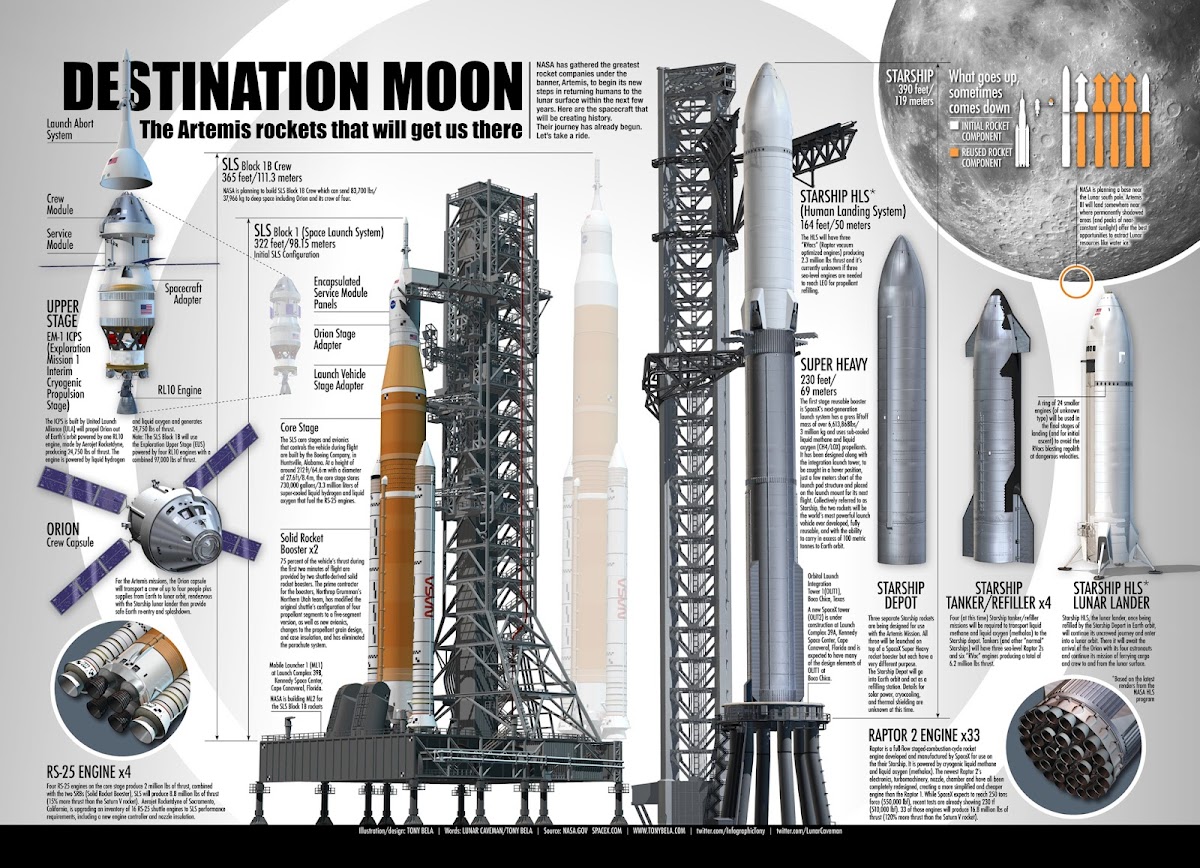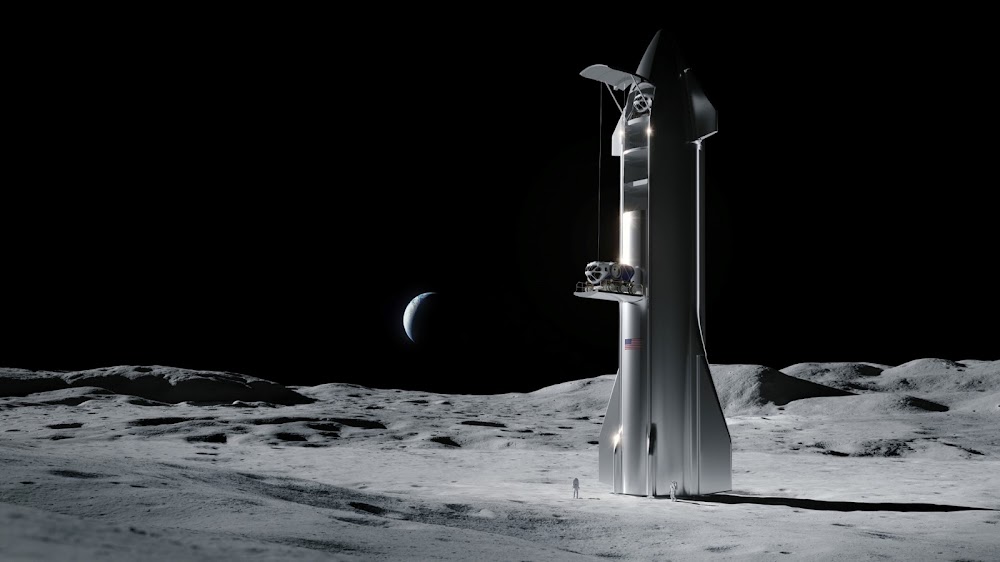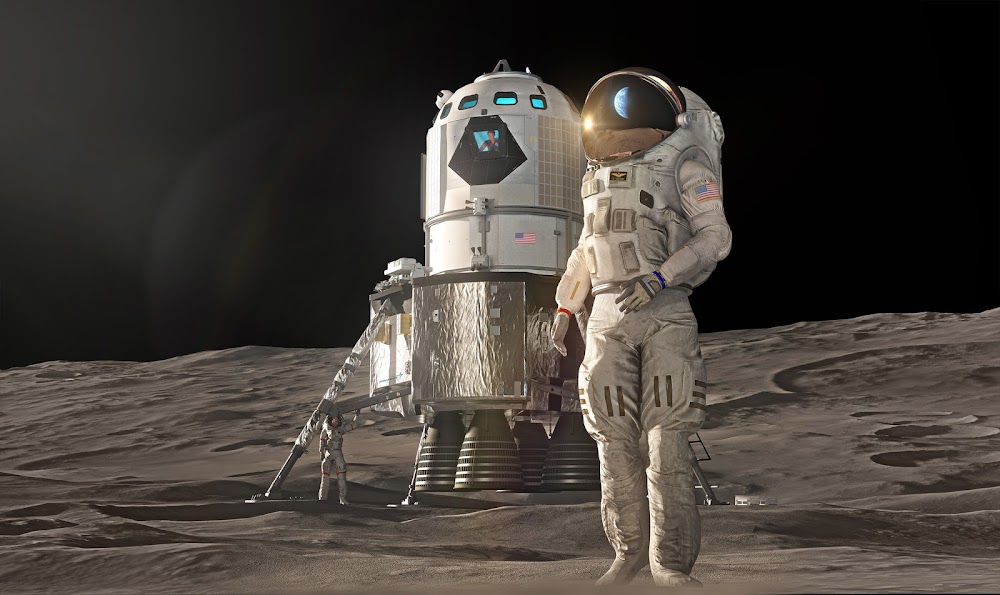An upgraded Lunar Starship for later Artemis missions:
Showing posts with label Artemis. Show all posts
Showing posts with label Artemis. Show all posts
Saturday, November 23, 2024
New design for SpaceX Lunar Starship
During the livestream of Starship Flight test 6 SpaceX presented a new design for the Lunar Starship (Human Landing System) which NASA has selected for the Artemis missions returning humans to the surface of the Moon. According to the current schedule SpaceX is tasked to get Artemis III crew on the surface of the Moon in the end of 2026; we estimate this mission will slip for about two years – to 2028 because developing a human-rated spacecraft is a lot harder task than building "just" a cargo rocket.
Sunday, April 28, 2024
NASA has revealed new designs of lunar cargo landers from SpaceX & Blue Origin
As we know NASA has contracted SpaceX and Blue Origin to provide landing systems to take astronauts to the Moon’s surface from lunar orbit, beginning with SpaceX's Lunar Starship for Artemis III mission.
On April 19, 2024, NASA announced it has asked SpaceX and Blue Origin to develop cargo versions of their human lunar landers as an option under their existing contracts. These cargo variants are expected to land approximately 12 to 15 metric tons (26,000 to 33,000 pounds) of payload on the lunar surface and be in service no earlier than the Artemis VII mission. In the announcement NASA shared the latest official renders of lunar cargo landers from SpaceX and Blue Origin:
On April 19, 2024, NASA announced it has asked SpaceX and Blue Origin to develop cargo versions of their human lunar landers as an option under their existing contracts. These cargo variants are expected to land approximately 12 to 15 metric tons (26,000 to 33,000 pounds) of payload on the lunar surface and be in service no earlier than the Artemis VII mission. In the announcement NASA shared the latest official renders of lunar cargo landers from SpaceX and Blue Origin:
SpaceX's Lunar cargo Starship
Blue Origin's Lunar cargo Lander
Sunday, September 4, 2022
Artemis rockets (SLS & Starship) that will get us to the Moon - infographic by Tony Bela
Australian space illustrator Tony Bela has created an infographic of Artemis rockets – NASA's Space Launch System (SLS), boosting Orion crew capsule to lunar orbit, and SpaceX's Human Landing System (known as Lunar Starship) – that will get the humanity back to the surface of the Moon.
You can download the infographic in its original resolution here.
Monday, September 13, 2021
Infographic of SpaceX Starship timeline by Ryan MacDonald
Exoplanet astronomer at Cornell University's Carl Sagan Institute Ryan MacDonald (known on social media as Martian Colonist) has created an infographic of SpaceX's aspirational timeline for Starship's first missions to the Moon and Mars.
We estimate realistically the timeline will slip for a few years with #dearMoon mission happening in 2025, Lunar Starship demo landing in 2026, humans returning to the Moon in 2027, first cargo mission landing on Mars in 2027 and first crew mission landing on Mars in 2031.
We estimate realistically the timeline will slip for a few years with #dearMoon mission happening in 2025, Lunar Starship demo landing in 2026, humans returning to the Moon in 2027, first cargo mission landing on Mars in 2027 and first crew mission landing on Mars in 2031.
Tuesday, August 3, 2021
SpaceX Lunar Starship delivering cargo for Artemis Base Camp
SpaceX's Lunar Starship, selected to return humans to the Moon, delivering cargo and crew for NASA's Artemis Base Camp on the Moon's South Pole. Concept artwork created by US 3D artist Nick Henning.
Friday, April 16, 2021
NASA selects SpaceX Lunar Starship to return humans to the Moon
 Today NASA announced it has selected SpaceX "to continue development of the first commercial human lander that will safely carry the next two American astronauts to the lunar surface" as part of the Artemis program. A year ago it was announced three contenders were selected to compete for this mission - SpaceX, Blue Origin's led "National Team" and Dynetics - and SpaceX revealed it is working for a lunar optimized Starship. Now we know SpaceX's proposal has won the race. In a milestone-based fixed-price contract SpaceX will be able to receive $2.89 billion to develop the Lunar Starship. The year when SpaceX needs to land humans back to the Moon is not specified yet.
Today NASA announced it has selected SpaceX "to continue development of the first commercial human lander that will safely carry the next two American astronauts to the lunar surface" as part of the Artemis program. A year ago it was announced three contenders were selected to compete for this mission - SpaceX, Blue Origin's led "National Team" and Dynetics - and SpaceX revealed it is working for a lunar optimized Starship. Now we know SpaceX's proposal has won the race. In a milestone-based fixed-price contract SpaceX will be able to receive $2.89 billion to develop the Lunar Starship. The year when SpaceX needs to land humans back to the Moon is not specified yet.In addition to today's announcement, NASA shared latest official render of SpaceX's Lunar Starship which slightly differs from last year's version:
Sunday, October 4, 2020
SpaceX Starship at NASA Artemis Base Camp by ICON
NASA is working, via its Artemis program, to establish a long-term human presence on and around the Moon by the end of the 2020s. Construction and expansion of Artemis Base Camp will require extensive use of lunar resources, including water ice (for life support and rocket fuel) and moon dirt (for building materials).
To accomplish goals of the SBIR contract ICON has teamed up with space design studio SEArch+ and Danish architecture firm BIG in Project Olympus to develop robotic construction concept for NASA's Artemis Base Camp. Here are several conceptual illustrations from the project.
First one depicts a spaceport featuring several 3D printed landing pads and roads, SpaceX's Starship in one of the pads and Blue Origin's Lunar lander with ICON's 3D printer landing in another:
Closeup of illustration's central part:
Here are illustrations of 3D printed habitats:
Monday, July 13, 2020
Cutaway diagram of SpaceX Lunar Starship
Unofficial cutaway diagram of SpaceX's Lunar Starship interior by Rocket Posters. The Lunar Starship is lunar optimized version (for NASA's Artemis program) of the fully reusable super heavy-lift spacecraft - Starship - currently developed by leading NewSpace company SpaceX.
Thursday, April 30, 2020
NASA selects SpaceX's lunar optimized Starship for Artemis program
Today NASA announced that three US companies - SpaceX, Blue Origin & Dynetics - will develop the human landers that will land astronauts on the Moon beginning in 2024 as part of the Artemis program. And SpaceX shared some renders of the "lunar optimized Starship" which is developed "to transport crew between lunar orbit and the surface of the Moon". SpaceX added that "a lunar optimized Starship can fly many times between the surface of the Moon and lunar orbit without flaps or heat shielding required for Earth return. With large habitable and storage volume, Starship is capable of delivering significant amounts of cargo for research and to support robust operations on the lunar surface to enable a sustainable Moon base."
Tuesday, November 19, 2019
HD quality official render of SpaceX cargo Starship unloading on the Moon
3 weeks ago SpaceX's Principal Mars Development Engineer Paul Wooster gave a presentation "SpaceX's Plans for Sending Humans to Mars" at 22nd Annual Mars Society Convention. In the presentation there was a new render of the redesigned SpaceX's cargo Starship unloading some NASA rovers on Lunar surface. Unfortunately no one was able to capture a decent quality image of the render then. Yesterday the render was posted on NASA's web page in high quality:
The post reveals that SpaceX is one of companies taking part in NASA’s Commercial Lunar Payload Services (CLPS) initiative which "allows rapid acquisition of lunar delivery services for payloads that advance capabilities for science, exploration, or commercial development of the Moon. Investigations and demonstrations launched on commercial Moon flights will help the agency study Earth’s nearest neighbor under the Artemis program. As its next step in exploration, NASA is preparing to send the first woman and next man to the Moon by 2024, establish sustainable lunar exploration by 2028, and plans to send astronauts to Mars in the mid-2030s."
The post reveals that SpaceX is one of companies taking part in NASA’s Commercial Lunar Payload Services (CLPS) initiative which "allows rapid acquisition of lunar delivery services for payloads that advance capabilities for science, exploration, or commercial development of the Moon. Investigations and demonstrations launched on commercial Moon flights will help the agency study Earth’s nearest neighbor under the Artemis program. As its next step in exploration, NASA is preparing to send the first woman and next man to the Moon by 2024, establish sustainable lunar exploration by 2028, and plans to send astronauts to Mars in the mid-2030s."
Monday, April 15, 2019
New official renders of Lockheed Martin's Lunar lander
American aerospace, advanced technologies and defense company Lockheed Martin has published two new renders of its Lunar lander. The lander seems to be scaled down a little if compared to the concept published last year. The purpose of the two-stage lander would be to ship 4 astronauts from NASA's planned Lunar Orbital Platform-Gateway to the surface of the Moon and back. The ascent stage is derived from the Orion spacecraft to ensure quicker development of the lander for an accelerated human return to the Moon as early as 2024 (according to the new aspirational timeline of NASA's leadership).
On 2017 Lockheed Martin also proposed its concept for a 4-person Martian lander.
On 2017 Lockheed Martin also proposed its concept for a 4-person Martian lander.
Ascent stage docked to the "Early Gateway" in Lunar orbit:
Saturday, October 13, 2018
Lockheed Martin's Lunar lander concept
American aerospace, advanced technologies and defense company Lockheed Martin has proposed a 62-ton Lunar lander to bring 4 astronauts from NASA's planned Lunar Orbital Platform-Gateway in near-rectilinear halo orbit to the surface of the Moon. The lander would be capable to support those astronauts on the surface for up to 14 days.
A year ago Lockheed Martin also proposed its concept for a 4-person Martian lander.
A year ago Lockheed Martin also proposed its concept for a 4-person Martian lander.
(Open link in new tab to view images in full resolution)
Subscribe to:
Posts (Atom)


















